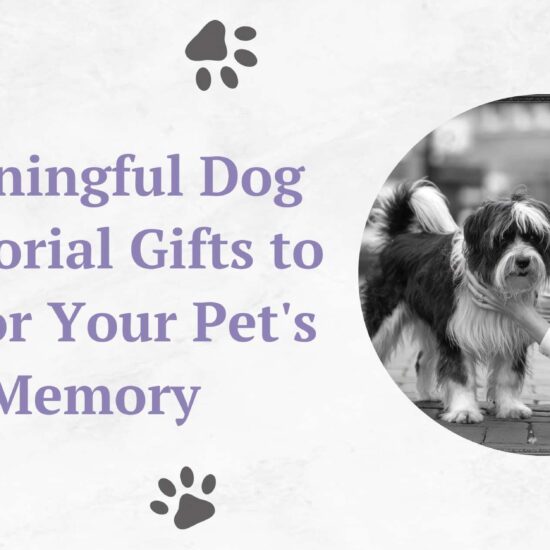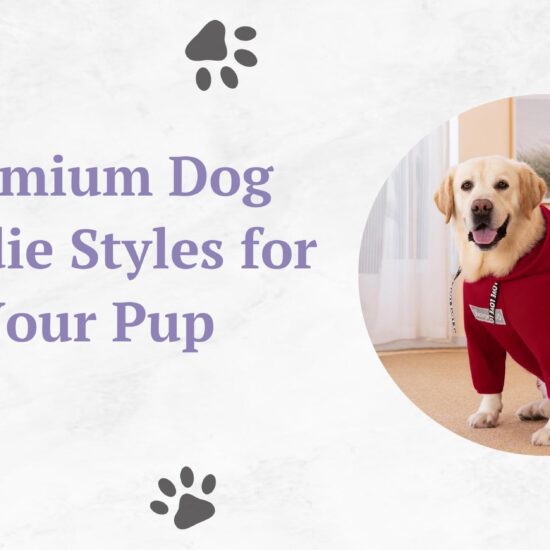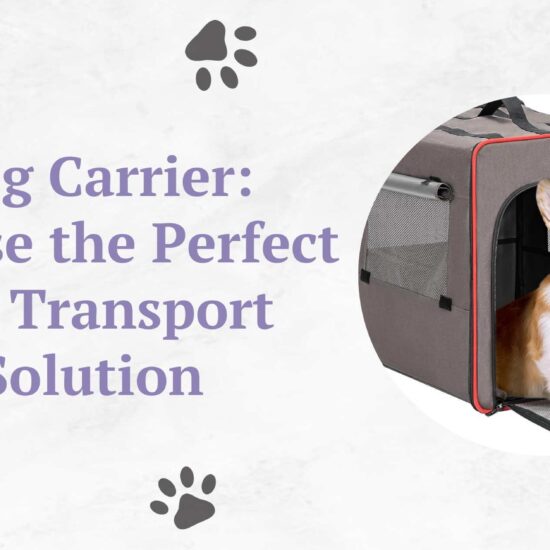Did you know that 64% of dog owners report behavioral improvements when their dogs engage in regular enrichment activities? DIY dog enrichment activities can transform your backyard into an exciting playground, providing both mental and physical stimulation for your furry friend.
From simple obstacle courses to creative digging boxes, these activities not only keep your dog entertained but also enhance their overall well-being.
In this comprehensive guide, we’ll explore various DIY dog enrichment ideas that are easy to implement and cost-effective. Whether you want to boost your dog’s agility, reduce anxiety, or simply add more fun to their day, our tips and suggestions will help you create a dynamic and engaging environment right in your backyard.
Let’s dive into the world of DIY dog enrichment and make your backyard the ultimate canine paradise!
Table of Contents
What is the Importance of Enrichment Activities?
Benefits of Dog Enrichment Activities
Enriching your dog’s life goes beyond the basic needs of food, shelter, and health care. By incorporating enrichment activities into your dog’s daily routine, you enhance their quality of life significantly. These activities not only keep them physically active but also mentally stimulated, leading to a happier and healthier companion. Let’s explore the detailed benefits of dog enrichment activities focusing on mental stimulation, physical exercise, and bonding between pets and owners.
Mental Stimulation: Reduces Boredom, Anxiety, and Destructive Behavior
Mental stimulation is crucial for a dog’s overall well-being. Just like humans, dogs can suffer from boredom and anxiety if their minds are not engaged. Here’s how mental stimulation through enrichment activities can address these issues:
- Reduces Boredom
- Activity Variety: Providing a range of activities such as puzzle toys, scent games, and interactive feeders can keep your dog engaged and entertained. These activities challenge their minds, preventing the monotony that often leads to boredom.
- Environmental Enrichment: Altering the environment regularly, like introducing new toys, rotating existing ones, or creating DIY activities, can pique your dog’s curiosity and keep their mind active.
- Positive Impact on Behavior: A mentally stimulated dog is less likely to develop negative behaviors such as excessive barking, digging, or chewing on furniture. These activities channel their energy into constructive play, making them calmer and more content.
2. Alleviates Anxiety
- Calming Activities: Activities like sniff walks or gentle massage can have a calming effect on anxious dogs. These activities allow them to focus on something positive, reducing stress levels.
- Predictable Routines: Enrichment activities that are integrated into a routine provide a sense of predictability and security. Knowing what to expect helps anxious dogs feel more in control and reduces anxiety.
- Engagement: Engaging in activities that require concentration can distract dogs from anxiety triggers. For example, solving a puzzle toy can keep their mind off a thunderstorm or separation from their owner.
3. Prevents Destructive Behavior
- Energy Outlet: Destructive behaviors often stem from a lack of mental stimulation and boredom. By providing mentally stimulating activities, you give your dog an outlet for their energy and curiosity.
- Training Opportunities: Enrichment activities can also double as training sessions. Teaching your dog new tricks or commands during these activities reinforces good behavior and redirects their focus from destructive habits.
- Self-Soothing: Interactive toys and puzzles can help dogs self-soothe when left alone, reducing separation anxiety and the tendency to engage in destructive behaviors.
Physical Exercise: Keeps Dogs Healthy and Active
Physical exercise is another pillar of canine enrichment. Regular exercise is essential for maintaining your dog’s physical health and preventing obesity-related issues. Here’s why physical exercise through enrichment activities is beneficial:
- Maintains a Healthy Weight
- Calorie Burning: Activities like fetch, agility courses, and tug-of-war burn calories, helping to maintain a healthy weight. Obesity in dogs can lead to numerous health problems such as diabetes, joint issues, and heart disease.
- Muscle Tone: Regular physical activity helps in building and maintaining muscle tone. Strong muscles support joint health, reduce the risk of injuries, and improve overall mobility.
- Metabolic Rate: Exercise boosts your dog’s metabolic rate, aiding in efficient digestion and nutrient absorption. This helps in maintaining a balanced weight and overall health.
2. Improves Cardiovascular Health
- Heart Health: Physical activities that increase your dog’s heart rate, such as running, playing frisbee, or agility training, strengthen the heart muscle. A strong heart pumps blood more efficiently, improving overall cardiovascular health.
- Lung Capacity: Exercise increases lung capacity and improves breathing efficiency. Activities like running or fetching encourage deep breaths, enhancing respiratory function.
- Circulation: Good circulation ensures that nutrients and oxygen are effectively delivered to all parts of the body, including vital organs. This supports overall bodily functions and enhances health.
3. Enhances Flexibility and Joint Health
- Joint Lubrication: Regular movement keeps joints lubricated, preventing stiffness and arthritis. Activities that involve varied movements, like obstacle courses, improve joint flexibility.
- Injury Prevention: Strengthening muscles around the joints through physical exercise helps in stabilizing them, reducing the risk of injuries during activities or daily movements.
- Mobility: Keeping your dog physically active from a young age ensures better mobility in their senior years. Regular exercise maintains their agility and overall movement capabilities.
4. Boosts Immune System
- Disease Prevention: Regular physical activity can strengthen the immune system, making dogs less susceptible to diseases. Exercise promotes the production of white blood cells, which fight infections.
- Longevity: Studies have shown that physically active dogs tend to live longer. The combination of good cardiovascular health, maintained weight, and robust immune function contributes to overall longevity.
Bonding: Enhances the Bond Between Dogs and Their Owners
Enrichment activities also play a significant role in strengthening the bond between dogs and their owners. This bond is built on trust, understanding, and shared experiences. Here’s how engaging in enrichment activities can enhance this bond:
- Quality Time
- Interactive Play: Activities like fetch, tug-of-war, or training sessions provide opportunities for direct interaction. Spending this quality time together strengthens your relationship and builds mutual trust.
- Communication: Engaging in these activities improves communication between you and your dog. You learn to understand each other’s signals, leading to a deeper connection.
- Emotional Connection: Sharing fun and positive experiences creates lasting memories and a strong emotional connection. This bond contributes to your dog’s sense of security and happiness.
2. Trust Building
- Positive Reinforcement: Training sessions and interactive games that use positive reinforcement build trust. Rewarding your dog for good behavior encourages them to rely on you and enhances their willingness to cooperate.
- Consistency: Regular enrichment activities establish a routine, which provides stability. This consistency helps build trust as your dog knows what to expect and feels secure in their environment.
- Problem-Solving Together: Working through puzzle toys or new tricks together fosters teamwork. Your dog learns to look to you for guidance and assistance, reinforcing their trust in you.
3. Improved Behavior
- Behavioral Training: Many enrichment activities can double as training sessions. Teaching your dog new commands or tricks during playtime improves their behavior and strengthens your bond.
- Stress Reduction: Activities that reduce your dog’s stress levels, like calming walks or massage, also benefit you. A calm and happy dog creates a peaceful and positive environment for both of you.
- Socialization: Enrichment activities that involve other dogs or people improve socialization skills. A well-socialized dog is easier to handle and more enjoyable to be around, enhancing your overall relationship.
4. Mutual Enjoyment
- Shared Joy: The joy of seeing your dog happy and engaged in activities can be incredibly fulfilling. This shared enjoyment strengthens the bond as both you and your dog benefit from the positive experiences.
- Increased Engagement: Dogs are more likely to engage in activities that involve their owners. Your participation makes the activity more interesting and rewarding for them, fostering a deeper connection.
- Better Understanding: Participating in enrichment activities allows you to understand your dog’s preferences, strengths, and weaknesses. This understanding helps in tailoring activities that suit their personality and needs, making the bond stronger.
Types of Enrichment Activities
Enrichment activities are essential for the overall well-being of dogs, providing them with mental and physical stimulation, enhancing their quality of life, and reducing behavior problems. Let’s dive into the different types of enrichment activities, focusing on sensory, cognitive, social, and environmental enrichment. Each of these categories engages dogs in unique ways, catering to their natural instincts and promoting healthier, happier lives.
Sensory Enrichment: Activities that Engage a Dog’s Senses (Sight, Smell, Touch)
Sensory enrichment activities stimulate a dog’s primary senses, offering them opportunities to explore and engage with their environment in meaningful ways. These activities cater to a dog’s natural curiosity and can help reduce anxiety and boredom.
- Sight
- Visual Stimuli: Introduce your dog to different visual stimuli by placing objects of various shapes, colors, and sizes in their environment. Moving toys, such as balls or feather toys, can catch their eye and encourage playful interaction.
- Bird Watching: Set up a bird feeder outside a window where your dog can watch birds. The movement and activity of birds can provide hours of visual entertainment for your dog.
- Interactive Videos: Some dogs enjoy watching videos designed for pets. These videos often feature moving animals and other engaging visuals that can keep your dog entertained.
- Smell
- Scent Trails: Create scent trails in your backyard or house using treats or scented objects. Hide treats along the trail and encourage your dog to follow the scent to find them. This engages their powerful sense of smell and provides mental stimulation.
- Snuffle Mats: These mats have fabric strips where you can hide treats. Your dog has to use their nose to find and retrieve the treats, mimicking the natural foraging behavior.
- Scent Discrimination Games: Use different scents, such as essential oils or spices, on various objects and train your dog to differentiate between them. This enhances their olfactory skills and provides mental exercise.
- Touch
- Texture Exploration: Introduce different textures for your dog to explore, such as soft blankets, rubber mats, or grass patches. Allowing them to walk on or play with various textures can stimulate their sense of touch.
- Massage and Grooming: Regular massages and grooming sessions can be very soothing for dogs. These activities also help in building trust and strengthening the bond between you and your dog.
- Obstacle Courses: Set up simple obstacle courses with items like pillows, boxes, and tunnels. These can challenge your dog’s sense of touch and balance as they navigate through the course.
Cognitive Enrichment: Activities that Challenge a Dog’s Brain (Puzzles, Games)
Cognitive enrichment activities are designed to engage a dog’s brain, challenging their problem-solving abilities and keeping their minds sharp. These activities are essential for preventing boredom and promoting mental well-being.
- Puzzle Toys
- Interactive Puzzle Toys: Toys that require your dog to solve a problem to get a reward, such as treat-dispensing balls or puzzle boards, can keep them mentally stimulated.
- DIY Puzzles: Create your own puzzles using household items. For example, hide treats in a muffin tin and cover them with tennis balls. Your dog has to figure out how to remove the balls to get the treats.
- Food-Dispensing Toys: Use toys that dispense food or treats when manipulated, like KONGs or treat balls. These toys encourage your dog to think and work for their food.
- Training Games
- Hide and Seek: Hide in different places and call your dog to find you. This game sharpens their listening and problem-solving skills while also providing exercise.
- Shell Game: Use three cups and hide a treat under one of them. Shuffle the cups and let your dog use their nose or paw to indicate which cup hides the treat. This game improves their focus and decision-making abilities.
- New Tricks: Teach your dog new tricks and commands. Learning new tasks keeps their brain active and reinforces positive behavior.
- Interactive Play
- Fetch with a Twist: Add challenges to a game of fetch, such as hiding the ball in different locations or using different types of balls and toys.
- Tug-of-War: Play tug-of-war with toys designed for safe play. This game engages their problem-solving abilities as they strategize how to win the game.
Social Enrichment: Activities that Involve Interaction with Other Dogs or Humans
Social enrichment activities involve interactions that can improve a dog’s social skills, reduce stress, and promote happiness. These activities help dogs form healthy relationships with other dogs and humans, fostering a sense of community and belonging.
- Playdates with Other Dogs
- Dog Playdates: Arrange playdates with other friendly dogs. Supervised play allows your dog to develop social skills and enjoy the company of their peers.
- Dog Parks: Visit dog parks where your dog can meet and interact with other dogs. Ensure that the park is safe and that your dog is comfortable with the environment.
- Human Interaction
- Training Sessions: Engage in regular training sessions that involve positive reinforcement. This not only builds your dog’s skills but also strengthens your bond.
- Family Time: Involve all family members in playtime and daily activities with your dog. This helps your dog feel like a valued member of the family.
- Therapy Dog Visits: If your dog enjoys social interactions and has a calm temperament, consider enrolling them in therapy dog programs where they can visit hospitals or nursing homes. This provides social stimulation and brings joy to others.
- Group Activities
- Group Classes: Enroll your dog in group obedience or agility classes. These classes provide structured socialization opportunities and help in building confidence.
- Dog-Friendly Events: Attend dog-friendly events or festivals where your dog can experience new environments and meet new people and dogs.
Environmental Enrichment: Creating a Stimulating Environment (Agility Courses, Digging Areas)
Environmental enrichment involves modifying or enhancing a dog’s living space to make it more engaging and stimulating. This can include adding new elements to their environment or creating specific areas for play and exploration.
- Agility Courses
- DIY Agility Courses: Set up simple agility courses in your backyard using household items like hula hoops, cones, and tunnels. Guide your dog through the course, gradually increasing the difficulty level.
- Professional Agility Equipment: Invest in professional agility equipment such as weave poles, A-frames, and balance beams. These can provide a more structured and challenging experience for your dog.
- Regular Practice: Incorporate agility training into your dog’s routine. This not only provides physical exercise but also mental stimulation as they learn to navigate the course.
- Digging Areas
- Designated Digging Spots: Create designated digging areas in your yard by filling a sandbox or a specific section of the garden with loose soil or sand. Encourage your dog to dig in these areas by hiding toys or treats.
- Rotating Toys: Rotate toys or hide different items in the digging area to keep it interesting and engaging for your dog.
- Positive Reinforcement: Praise and reward your dog when they use the designated digging area. This helps reinforce the behavior and prevents them from digging in undesired spots.
- Sensory Gardens
- Pet-Friendly Plants: Plant a variety of pet-safe plants such as catnip, lavender, and grasses. These plants can provide sensory stimulation through their scents and textures.
- Water Features: Install a small water feature or fountain that your dog can play with. Moving water can be intriguing and enjoyable for many dogs.
- Pathways and Hiding Spots: Create pathways and hiding spots with bushes or tall grasses. This encourages exploration and provides a sense of adventure for your dog.
- Outdoor Toys and Activities
- Outdoor Toys: Provide durable outdoor toys such as ropes, balls, and chew toys that can withstand different weather conditions.
- Sprinkler Play: On hot days, set up a sprinkler or kiddie pool for your dog to play in. Water activities can be both fun and cooling.
- Hide and Seek: Hide toys or treats around the yard and let your dog use their senses to find them. This engages their natural foraging instincts and provides mental stimulation.
DIY Dog Enrichment Activities
Enrichment activities are essential for a dog’s mental and physical health. They keep your pet engaged, reduce boredom, and contribute to overall well-being. Here are some creative DIY dog enrichment activities you can try to make your backyard a fun and stimulating environment for your furry friend.
Sniff Walks: Allow Dogs to Lead the Way and Explore Scents
Sniff walks are a fantastic way to engage your dog’s natural instinct to explore their environment through smell. Unlike regular walks where the goal is exercise, sniff walks allow your dog to take the lead, stop frequently, and investigate different scents. This activity provides mental stimulation and satisfaction.
- Benefits of Sniff Walks
- Mental Stimulation: Engages the brain as dogs process new and diverse smells.
- Reduces Anxiety: Calming effect by focusing on the environment rather than stressors.
- Encourages Natural Behavior: Allows dogs to behave instinctually, fostering a sense of freedom and happiness.
- How to Conduct a Sniff Walk
- Choose a Location: Pick a safe, varied environment such as a park or wooded area.
- Let Your Dog Lead: Allow your dog to guide the walk, stopping as often as they like.
- Time: Aim for at least 30 minutes to an hour, depending on your dog’s interest.
- Tips for Sniff Walks
- Safety First: Ensure the area is safe, free from hazards or toxic plants.
- Variety: Change routes frequently to keep the experience fresh and engaging.
- Pace: Let your dog set the pace, don’t rush them.
Agility Courses: Set Up Obstacles Like Tunnels, Jumps, and Weave Poles
Agility courses are an excellent way to provide both mental and physical stimulation. Setting up a DIY agility course in your backyard can be a fun and effective way to exercise your dog.
- Benefits of Agility Courses
- Improves Agility and Coordination: Enhances your dog’s physical abilities.
- Reduces Hyperactivity: Provides an outlet for pent-up energy.
- Mental Challenge: Navigating obstacles requires focus and problem-solving.
- Setting Up an Agility Course
- Obstacles: Use items like cones, PVC pipes, and wooden planks to create jumps, tunnels, and weave poles.
- Layout: Design a course that challenges your dog but is safe and achievable.
- Training: Start with simple obstacles and gradually increase the complexity as your dog becomes more skilled.
- Tips for Agility Training
- Positive Reinforcement: Use treats and praise to encourage your dog.
- Short Sessions: Keep training sessions short and fun to maintain your dog’s interest.
- Safety: Ensure all obstacles are secure and free from sharp edges.
DIY Puzzle Toys: Use Household Items to Create Treat-Dispensing Toys
Puzzle toys are great for mental stimulation, as they challenge your dog to figure out how to obtain a reward. You can create DIY puzzle toys using common household items.
- Benefits of Puzzle Toys
- Enhances Cognitive Skills: Encourages problem-solving and critical thinking.
- Reduces Boredom: Keeps your dog occupied and entertained.
- Slows Down Eating: Helps prevent gulping food too quickly, which can aid digestion.
- Creating DIY Puzzle Toys
- Toilet Roll Tubes: Place treats inside the tubes and fold the ends.
- Muffin Tins: Hide treats in the cups and cover them with tennis balls or paper.
- Plastic Bottles: Punch holes in a plastic bottle, place treats inside, and let your dog roll it around to get the treats.
- Tips for Puzzle Toys
- Supervision: Always supervise your dog to ensure they don’t swallow any parts.
- Level of Difficulty: Adjust the difficulty level based on your dog’s skill.
- Rotation: Rotate toys to keep the experience fresh.
Interactive Games: Play Fetch, Tug-of-War, and Hide-and-Seek
Interactive games are a fantastic way to bond with your dog while providing physical exercise and mental stimulation.
- Benefits of Interactive Games
- Strengthens Bond: Enhances the relationship between you and your dog.
- Provides Exercise: Keeps your dog physically fit and active.
- Mental Engagement: Games like hide-and-seek require your dog to use their nose and brain.
- Types of Interactive Games
- Fetch: Use balls, frisbees, or sticks to play fetch. Vary the throw distance and direction to keep it interesting.
- Tug-of-War: Use a sturdy rope or tug toy for this game. Ensure your dog plays safely and understands the command to release.
- Hide-and-Seek: Hide treats or toys around the yard and let your dog find them. You can also hide and call your dog to find you.
- Tips for Interactive Games
- Balance: Mix physical games with mental challenges to provide balanced stimulation.
- Safe Equipment: Use safe, non-toxic toys that are appropriate for your dog’s size and strength.
- Training Opportunities: Incorporate basic commands like sit, stay, and come during play.
Pet-Friendly Garden: Designate Areas for Digging, Planting Pet-Safe Plants
Creating a pet-friendly garden is a wonderful way to allow your dog to explore and enjoy the outdoors safely.
- Benefits of a Pet-Friendly Garden
- Safe Exploration: Allows your dog to explore without the risk of toxic plants or hazards.
- Natural Behaviors: Provides opportunities for digging, sniffing, and playing in a controlled environment.
- Aesthetic Appeal: Enhances your backyard with plants and features that are safe for pets.
- Creating a Pet-Friendly Garden
- Digging Area: Designate a specific area for your dog to dig. Fill it with loose soil or sand and hide toys or treats to encourage digging in that spot.
- Pet-Safe Plants: Plant pet-safe flowers and herbs like lavender, marigold, and rosemary. Avoid toxic plants such as lilies, azaleas, and daffodils.
- Pathways and Shade: Create pathways for your dog to explore and areas of shade for resting.
- Tips for a Pet-Friendly Garden
- Fencing: Ensure your garden is securely fenced to prevent your dog from wandering off.
- Regular Maintenance: Check for any hazards like sharp objects or toxic plants that may have found their way into the garden.
- Engagement: Spend time with your dog in the garden to encourage exploration and play.
Fun backyard enrichment ideas for your dog:
Puzzles and toys
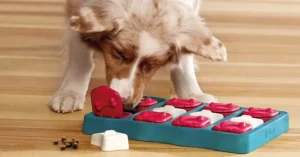
One of the best ways to keep your dog happy is to get them puzzles and toys that they can play with. You can create these toys from everyday items, providing hours of entertainment for kids. You can get your dog to use their nose and brain to find the treats by putting them in a plastic bottle with holes or making a snuffle mat out of fabric strips. They will keep your dog busy. You can transform your garden into a thrilling treasure-hunt playroom by adding these toys. Furry Talez advises you to frequently switch up your dog’s toys to keep them interested and give them new tasks.
Constructing Obstacle Course
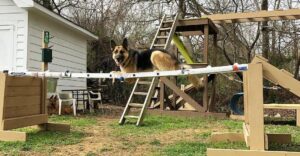
Constructing an obstacle course in your garden is another fantastic idea for keeping your dog occupied. You can make jumps, tunnels, and weave poles from things you find around the house, like hula hoops, pool noodles, and cardboard boxes. Your dog can get better at obedience and agility if you use dog training tricks to help them get through the course. This strengthens your relationship with your pet and gives them a relaxing way to get rid of extra energy. DIY dog enrichment activities like this are great for breeds that have a lot of energy and must always be active. Furry Talez advises pet owners to change the course plan frequently to keep their pets interested and challenged.
Note: There might be affiliate links mentioned here. We may receive a commission if you purchase a product through an affiliate link. There is no additional charge for you. Please do your own research before making any online
Sensory Gardens
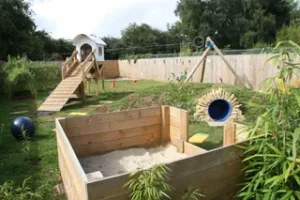
A sensory garden is a great way to keep your dog’s body and mind busy. Planting a variety of dog-friendly herbs and flowers, such as mint, lavender, and rosemary, can offer them a delightful array of flavours and aromas. You can create a stimulating environment by incorporating elements like digging sand pits, splashing water features, and contrasting textures such as grass and gravel. Anyone can make these “DIY dog enrichment activities” in their yard in no time. They give dogs lots of chances to play and explore. Furry Talez emphasizes the importance of selecting safe plants and items for your dog’s sensory garden.
Water Play Areas
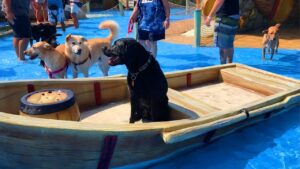
Water is great to add to your backyard entertainment setup because many dogs love to play with it. On hot days, simple water activities like making a splash pad, setting up a baby pool, or using sprinklers can keep kids entertained for hours. The DIY dog enrichment activities listed below are excellent ways to keep your dog cool and give them a great way to play. Water toys that float or squirt can add extra fun. Furry Talez experts say you should always watch your dog play in the water to ensure their safety and avoid mistakes.
Hide and Seek Games
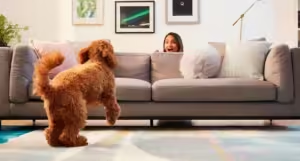
Playing hide-and-seek with your dog is a great way to tap into their innate hunting abilities. Tell your dog to find their favorite toys or treats hidden around the yard. It’s possible to make this game harder by making it harder to hide each time. Before letting your dog look, using dog training tricks like sit and stay can make the game more like obedience. These DIY dog enrichment activities will keep your dog’s mind active, helping it focus and learn how to solve problems. Furry Talez shows how important it is to keep the game fun and satisfying by giving your dog treats or praise.
Statistical Data on Dog Enrichment activities
| Activity Type | Benefits | Statistics |
|---|---|---|
| Sniff Walks | Reduces anxiety, boredom | 40% increase in mental stimulation |
| Agility Courses | Improves agility, reduces hyperactivity | 30% more active dogs |
| Puzzle Toys | Enhances cognitive skills | 25% decrease in destructive behavior |
| Interactive Games | Strengthens bond, provides exercise | 35% happier dogs |
Conclusion
It’s important for your dog’s health and happiness to keep them busy. Make your backyard into a fun and useful place by using your imagination.There are many options, like sensory gardening, water play areas, interactive toys, and obstacle courses. There are a lot of “do-it-yourself dog enrichment activities” that can help you bond with your pet. Contact Furry Talez experts who aim to help pet owners give their pets enjoyable and fulfilling experiences. If you use these ideas for fun things to do, your pet will enjoy their garden even more.
Disclaimer: The information provided in this article is for educational purposes only and should not be considered as a substitute for medical advice. Consult a registered Veterinary practitioner before using or trying any product suggested here in this article.
FAQs
What are some simple DIY dog enrichment activities?
Try creating obstacle courses, using treat-dispensing toys, or setting up a digging box in your backyard.
How do I make my backyard fun for my dog?
Incorporate a variety of activities like agility courses, water play areas, and sensory gardens to keep your dog entertained.
Are DIY dog enrichment activities safe?
Yes, as long as you use pet-safe materials and supervise your dog during play to ensure their safety.
Can enrichment activities help with my dog’s behavior?
Absolutely, enrichment activities can reduce boredom and anxiety, leading to better behavior and a happier dog.
What materials do I need for DIY dog toys?
You can use everyday items like PVC pipes, old towels, and tennis balls to create fun and engaging toys for your dog.



